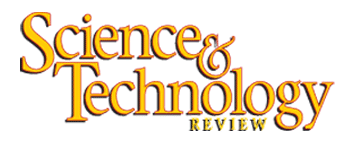Nanosensors Based on Functionalized Nanoparticles and Surface Enhanced Raman Scattering
Chad E. Talley, Thomas R. Huser, Christopher W. Hollars,
Stephen M. Lane, Joe H. Satcher, Jr., Bradley R. Hart, Ted A. Laurence
U.S. Patent 7,301,624 B2
November 27, 2007
Surface-enhanced Raman spectroscopy (SERS) is a vibrational spectroscopic technique that uses metal surfaces to enhance signals by several orders of magnitude. When molecules of interest are attached to designed metal nanoparticles, a SERS signal is attainable with single-molecule detection limits. This technique provides an ultrasensitive means of detecting molecules. With selective chemistries, metal nanoparticles can be functionalized to provide a unique signal on analyte binding. With measurement techniques, such as radiometric received SERS spectra, metal nanoparticles can be used to monitor dynamic processes and static binding events. Accordingly, nanoparticles can be designed as nanosensors for a wide range of chemicals in fluid, gaseous, and solid form; as environmental sensors for pH, ion concentration, and temperature; and as biological sensors for proteins, DNA, and RNA.
High-Resolution Ophthalmic Imaging System
Scot S. Olivier, Carmen J. Carrano
U.S. Patent 7,303,280 B2
December 4, 2007
This system produces a retinal image with improved resolution. An imaging camera captures the image. A computer system connected to the camera produces short exposures of the image and uses speckle processing to improve resolution.
Nanostructured Materials for Hydrogen Storage
Andrew J. Williamson, Fernando A. Reboredo
U.S. Patent 7,303,736 B2
December 4, 2007
This hydrogen storage system comprises hydrogen absorbed on the surfaces of porous nanostructured semiconductor material.
UWB Communication Receiver Feedback Loop
Alex Spiridon, Dave Benzel, Farid U. Dowla, Faranak Nekoogar,
Erwin T. Rosenbury
U.S. Patent 7,305,052 B2
December 4, 2007
This system maximizes the extraction of information from reference pulses for ultrawideband (UWB) transmitted reference (TR) receivers. The system efficiently processes an incoming signal to suppress different types of UWB and non-UWB interference prior to signal detection. The system adds a feedback loop to enhance the signal-to-noise ratio of reference pulses in a conventional TR receiver. Sampling the second-order statistical function, such as the autocorrelation function (ACF) of the received signal, and matching it to the ACF samples of the original pulses for each transmitted bit, provides a more robust UWB communications system in the presence of channel distortions.
High Resistivity Aluminum Antimonide Radiation Detector
John W. Sherohman, Arthur W. Coombs III, Jick H. Yee
U.S. Patent 7,309,393 B2
December 18, 2007
Bulk aluminum antimonide–based single-crystal materials have been prepared for use as ambient (room) temperature x- and gamma-ray radiation detection.
Microelectromechanical Systems Contact Stress Sensor
Jack Kotovsky
U.S. Patent 7,311,009 B2
December 25, 2007
This contact stress sensor includes a microelectromechanical systems silicon body. A recess is formed in the silicon body, and a silicon element extends into the recess. The silicon element has limited freedom of movement within the recess. An electrical circuit in the silicon element includes a piezoresistor material that allows for sensing changes in resistance proportional to bending of the silicon element.
Deposition of Dopant Impurities and Pulsed Energy Drive-In
Paul Wickboldt, Patrick M. Smith, Albert R. Ellingboe
U.S. Patent RE39,988 E
January 1, 2008
A semiconductor doping process enhances the dopant incorporation achievable using a gas-immersion laser. First, a thin layer of dopant atoms is deposited on a semiconductor surface. Then the surface is exposed to one or more pulses from either a laser or an ion beam. These pulses melt a portion of the semiconductor to a desired depth, thus causing the dopant atoms to be incorporated into the molten region. After the molten region recrystallizes, the dopant atoms are electrically active. Plasma-enhanced chemical vapor deposition or other known deposition techniques are used to deposit the dopant atoms. |
